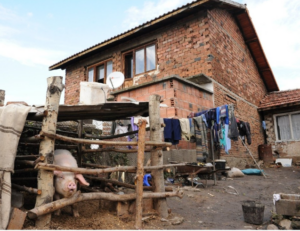One of the most common challenges in housing is the topic of affordability.
Many international organizations have acknowledged the housing affordability question ranging from the OECD, the International Monetary Fund, and the joint research center from the European Commission.
It is not only affecting low-income households. It’s also increasing to the point that it’s impacting middle-income earners. The crucial point is that these challenges are not limited to individual residents. It’s a question of economic stability and social equality.
The other key challenge is the housing quality crisis. This issue is broad and covers thermal insulation, cooling systems as well as energy poverty. Thanks to renovations, residents benefit not only from living in warmer homes but also from paying lower energy bills.
It’s also important to note there is not just one policy that will solve all the different challenges. Some areas are seeing populations increase. Other regions are seeing a decline. It requires multiple solutions and various approaches.
The Definition(s) of Social Housing
It’s essential to keep in mind that there is no single or official definition for social housing that is applied across Europe.
Each country defines it differently. Often the term social housing is used as a shortcut to refer to specific programs or schemes that have been implemented. However, the common ground is that the idea of social housing is more affordable than what is offered on the market.
It is allocated to specific rules. It provides an opportunity to find decent homes for those who cannot secure it on the market. It’s also financed to some extent by public intervention.
There is also a common challenge. There has been a decrease in public funding and support over the last decade. But the spending on benefits to the housing to maintain the properties or pay rents has remained consistent or increased in many countries.
The Common Housing Policy Objectives
While the needs for housing across Western, Southern, and Eastern Europe are different, there are also some similarities.
- Across all areas, it’s critical to ensure access to affordable housing.
- All regions need to improve housing conditions for specific groups such as homeless and young people.
- There is a demand to enhance the quality of housing and energy efficiency in all areas.
- In Western Europe, there must be more housing supply due to the lack of land to build on.
- It’s critical to strengthen institutional capacity and regulatory framework.
- In Southern and Eastern Europe, there should be a focus on increasing housing in a specific tenure.
There are different starting points for each location. In addition, various regions require a focus on multiple groups. However, the objective remains the same in all areas.
The Regional Varieties of Affordability
One of the most critical factors influencing affordability is the economic structure development. It includes the growth models and how the welfare system intervenes in the social inequalities across Europe.
Breaking it down into the simplest state, the new member states have a much lower GDP. They also have a very different economic growth model.
Another element is that the condition of housing is different across regions. For example, if you compare the average size of apartments and houses, it’s 30% smaller in new member states compared to the rest of Europe. The housing finance system is less developed when comparing the outstanding mortgage rate to the GDP ratio. In new member states, it’s 18% compared to 50% in the rest of Europe.
Growing vs. Shrinking Regions
In countries that are seeing growth, there is demographic pressure. There is also a shortage of land and issues with building regulations. The price of housing and rent is even increasing faster than the average income in these areas.
For countries that are decreasing in population, the problem is the quality of housing. The mortgage market is also much more severe, resulting in higher costs.
There is a trend that this discrepancy is increasing.
What is the Way Forward?
There is a need for a compassionate governance that creates an opportunity for all to access housing. A poorly regulated system can be detrimental to society, the economy, health, and urban planning.
Some guiding principles need to get established. For example, one should be that a home is not just a house. Once we can shift this mindset, it changes the focus to houses being generators of humans flourishing and becoming connectors to a network of open and green spaces. It can also be the foundation of political and economic resilience. It even establishes that there is a right to housing.
A good housing system requires proactive leadership and commitment based on participatory governance. It also needs to be about community engagement in addition to regulation, inclusive design, financial security, identity, and belonging.
Furthermore, everyone of us can influence the process by changing our attitude towards housing. Simple things like improving the energy efficiency of your building or supporting government representatives who aim to improve housing conditions. Simply because everyone deserves a decent place to live.
Without a functioning housing system based on a justly governed system that sees a direct relationship between these elements, our society cannot truly flourish.
Do you want to be part of the action? Sign up to find out about upcoming events, interviews, and articles on the future of housing.
Moderator: Gerald Koessel – Researcher at GbV, Austria
Speakers:
- Alice Pittini – Housing Europe Observatory Director
- Grzegorz Gajda – Senior Urban Specialist, European Investment Bank
- Jozsef Hegedus – Metropolitan Research Institute
- Rachael Marie Scicluna – Housing, Strategy and Policy Consultant within the Ministry of Social Accommodation, Malta
Interested in learning more? Watch other session too.
- Addressing Housing Deprivation of Romain Central and Eastern Europe
 The Roma, Europe’s largest ethnic minority, faces stark disparities in living conditions, experiencing housing deprivation at significantly higher rates than other populations. This issue persists across Central and Eastern Europe, despite a robust… Read more: Addressing Housing Deprivation of Romain Central and Eastern Europe
The Roma, Europe’s largest ethnic minority, faces stark disparities in living conditions, experiencing housing deprivation at significantly higher rates than other populations. This issue persists across Central and Eastern Europe, despite a robust… Read more: Addressing Housing Deprivation of Romain Central and Eastern Europe - What is Energy Poverty?
 Energy powers communities. Healthcare workers and teachers depend on energy to heal and educate their communities. Energy keeps homes warm in the winter and cool in the summer. Moreover, it fuels agricultural and… Read more: What is Energy Poverty?
Energy powers communities. Healthcare workers and teachers depend on energy to heal and educate their communities. Energy keeps homes warm in the winter and cool in the summer. Moreover, it fuels agricultural and… Read more: What is Energy Poverty? - Habitat converts and renovates underutilized spaces into housing
 This article is an extract from the Habitat Magazine – May 2023. Reviving empty spaces in the UK The high cost of land and construction in the United Kingdom prevents many developers from… Read more: Habitat converts and renovates underutilized spaces into housing
This article is an extract from the Habitat Magazine – May 2023. Reviving empty spaces in the UK The high cost of land and construction in the United Kingdom prevents many developers from… Read more: Habitat converts and renovates underutilized spaces into housing - 7 sustainable housing designs: Passivhaus in Western Europe
 Sustainability is a hot topic in all corners of the world. From e-commerce to politics, industries across the globe are investigating old processes and coming up with new innovative methods to deliver their… Read more: 7 sustainable housing designs: Passivhaus in Western Europe
Sustainability is a hot topic in all corners of the world. From e-commerce to politics, industries across the globe are investigating old processes and coming up with new innovative methods to deliver their… Read more: 7 sustainable housing designs: Passivhaus in Western Europe - Affordable housing statistics across Western Europe
 One of the most popular topics of conversation around the world is the housing affordability crisis. The cost of living combined with inflation has significantly impacted citizens across Europe. What’s also clear is… Read more: Affordable housing statistics across Western Europe
One of the most popular topics of conversation around the world is the housing affordability crisis. The cost of living combined with inflation has significantly impacted citizens across Europe. What’s also clear is… Read more: Affordable housing statistics across Western Europe - What Happened at the Europe Housing Forum 2021? (Executive Report)
 The Europe Housing Forum is a conference organized by Habitat for Humanity International, alongside multiple partners and donors, that gathers under one roof major stakeholders engaged in seeking solutions to affordable housing issues… Read more: What Happened at the Europe Housing Forum 2021? (Executive Report)
The Europe Housing Forum is a conference organized by Habitat for Humanity International, alongside multiple partners and donors, that gathers under one roof major stakeholders engaged in seeking solutions to affordable housing issues… Read more: What Happened at the Europe Housing Forum 2021? (Executive Report)

